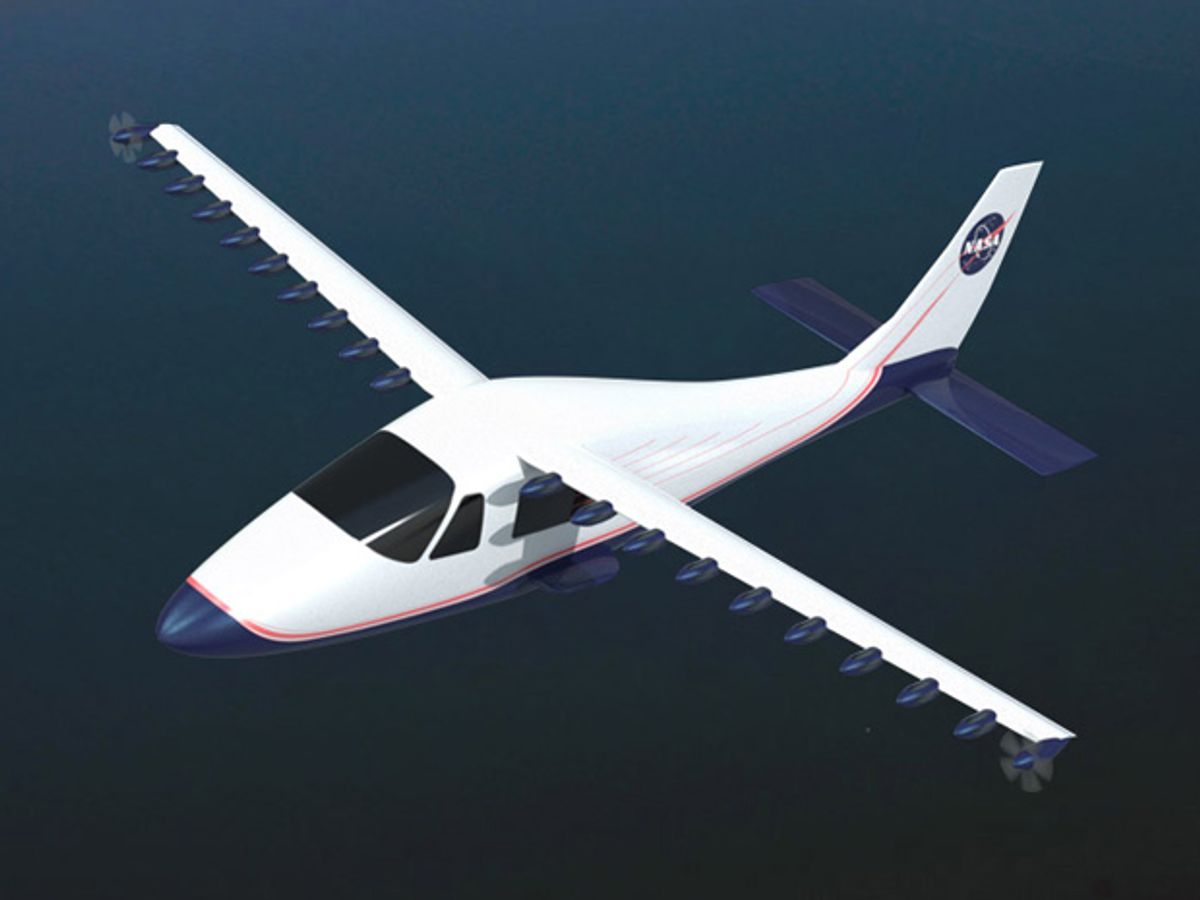NASA’s X-plane program has, for the past 70 years, demonstrated some of the most exciting and innovative aircraft ever flown, including rockets and robots, scramjets and spacecraft (and lots more). It’s always worth paying attention when a new X-plane is announced, and NASA has just given us a hint of what the X-57 might be: LEAPTech, an experimental demonstrator that replaces the single large motor on light aircraft with 18 (!) tiny ones, all mounted on an impossibly skinny little wing.
The specs on the LEAPTech X-plane are, for the most part, not anything to get super-excited about. With a top speed of 320 km/h and a 3567 meter (12,000 ft) ceiling, it’ll be able to carry four passengers 740 km on hybrid electric power. This is all about average for a light aircraft of this size. What’s unique are those 18 electric engines, and the wing, which has a total area of just over 5 square meters. In order to fly, a conventional airplane of this size needs three times as much wing area at the expense of the huge amount of extra drag that comes with it.
LEAPTech’s big innovation is using 18 small engines to blow air directly across the wing, the part of the aircraft that generates the most lift. Traditionally, aircraft have a big engine or two that are used exclusively for forward propulsion, and lift is generated by the wing as a side-effect of that forward movement. As a result, wings have to be relatively large in order to provide sufficient lift at lower speeds (takeoffs and landings), and at higher cruising speeds, but all of that wing area just slows the aircraft down.
The LEAPTech X-plane tightly integrates engines with wings, so the engines all work together to maximize the amount of air moving directly over the lift surfaces. By doing this, the wing can be optimized for cruising speeds instead of takeoff speeds, drastically improving cruise efficiency. The only reason this concept works is that with electric motors, you can just slap 18 of ‘em on there, because of how well they scale in size, weight, and power.
The technique of using engines to force air over wing surfaces to improve lift is called “blowing,” and and NASA has been experimenting with how engine position can augment lift for decades. My favorite example of this is the Quiet Short-Haul Research Aircraft (QSRA), developed by Boeing and NASA Ames in the 1980s, which mounted its engines on top of its wings to convert engine exhaust into lift:
The QSRA operated with about 10% of the length of runway that a typical airliner would use, and could get airborne at a speed of just 80 mph, only about 50% of the takeoff speed of an aircraft of its size. The top-mounted engines also had the pleasant side-effect of making the aircraft 90% quieter than similar transports.
LEAPTech is taking things one step farther than the QSRA; combining wing-mounted engines with minimal wing loading in order to maximize its lift-to-drag ratio. To put that in context, a Cirrus SR22 has a lift-to-drag ratio of 11, while the LEAPTech X-Plane should be up over 22. A higher number (more units of lift per unit of drag) means a more efficient aircraft, in the form of higher fuel economy, incrased climb performance, and a better glide ratio. By way of comparison, the lift-to-drag ratio of a Cessna 150 is around 7, a Boeing 747 is at 17, an albatross manages to hit 20, and the U-2 high altitude spy plane is up at 28. Topping the list at 37 (for powered aircraft) is Virgin Atlantic's GlobalFlyer, which flew around the world in under three days without stopping for fuel.
By keeping the target performance about the same as a Cirrus SR22 or similar light aircraft, the LEAPTech X-Plane should see a boost in fuel economy of about 60%, along with a much better ride and “drastically reduced” noise signature.
As with most aircraft, maximum power isn’t usually required for efficient long distance cruising, and after takeoff, all 18 engines won’t be necessary on the LEAPTech X-plane. Since the whole point of this project is about minimizing drag, it would be silly to have a bunch of extra propellers just getting in the way during cruise, so some of them will fold up nice and snug against their nacelles to make the plane as aerodynamic as possible:
It’s important to point out, though, that the focus of this X-plane is high efficiency takeoffs and landings, and that the design isn’t really being optimized for cruise. The final configuration of the X-plane might even include more propellers to maximize cruise efficiency, including propellers mounted on the wingtips to take advantage of wingtip vortices, and another propeller mounted on the tail boom.
Right now, the LEAPTech aircraft looks like this:
The 31 foot wing, complete with its 18 engines, is out at Edwards Airforce Base, where it’ll be driven along a dry lakebed at speeds up to 70 mph to see how it fares. The next step in the project (to happen within the next few years) is to rip the wing and engines off of a Tecnam P2006T and replace it with the LEAPTech wing and engines, making it easy for engineers to compare the performance of the LEAPTech X-plane with a conventional light aircraft.
NASA hopes that if this X-plane is successful, it’ll help the aircraft industry to begin to transition to electric propulsion within the next decade, starting with smaller light aircraft, and eventually being applied to larger transport aircraft. With futuristic airliners like this on the horizon, we’re excited to get things moving:

Evan Ackerman is a senior editor at IEEE Spectrum. Since 2007, he has written over 6,000 articles on robotics and technology. He has a degree in Martian geology and is excellent at playing bagpipes.






